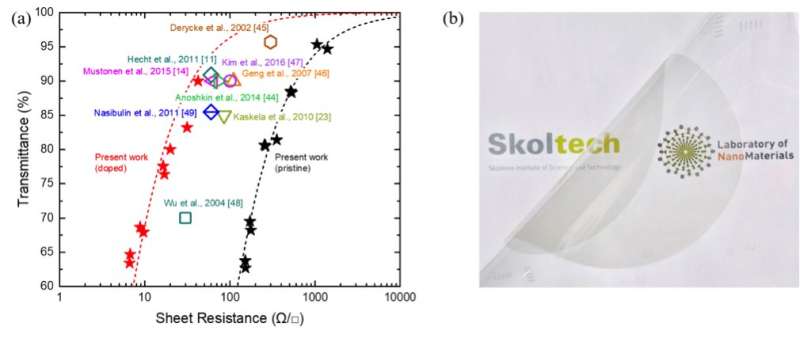Team develos new process for manufacturing SWCNT films

In a finding that could accelerate the development of next-generation wearable and flexible electronics, a team of Skoltech scientists led by Professor Albert Nasibulin has discovered a revolutionary means of improving the optical and electrical properties of carbon nanotubes.
Next-generation electronics will be flexible, stretchable, have enhanced battery life, and be usable outdoors. The transparent metal oxide films currently favored by the industry have several drawbacks, including with respect to reflection, brittleness, bendability the high cost of raw materials, and environmentally damaging resource extraction processes. These drawbacks limit the utility of these films for next-generation devices like wearable electronics, display technologies and photovoltaics.
Films made of single-walled carbon nanotubes (SWCNTs) could replace their metal oxide counterparts in future electronics. In comparison to metal oxide films, those made of single-walled carbon are flexible, durable, and chemically stable. However, in order to become viable replacements, the opto-electrical characteristics of carbon nanotube films need to be improved.
The Skoltech team developed single-walled carbon nanotubes films that match their metal-oxide counterparts with respect to opto-electrical characteristics. In particular, the team revised the doping process, the act of covering a surface with a thick liquid. This is a pivotal step when it comes to changing a material's electrical and optical characteristics.
"In this work, we used gold chloride as the most effective dopant for the single-walled carbon nanotubes films. We were able to improve the opto-electrical characteristics of the films by optimizing the doping solvent and conditions. We have examined and demonstrated the effect of several of the most common solvents at different temperatures on the opto-electrical characteristics," said Skoltech Ph.D. student Alexey Tsapenko, the lead author of the study.
The results of the study show state-of-the-art optoelectrical characteristics, with a sheet resistance value of as low as 40 Ω/sq−1 at the transmittance of 90 percent in the visible range. The reported value demonstrated a superior performance increase of films based on single-walled carbon nanotubes compared to previously conducted and discussed research in literature. The results of the study have been published in Carbon.
More information: Alexey P. Tsapenko et al. Highly conductive and transparent films of HAuCl 4 -doped single-walled carbon nanotubes for flexible applications, Carbon (2018). DOI: 10.1016/j.carbon.2018.01.016
Journal information: Carbon
Provided by Skolkovo Institute of Science and Technology



















